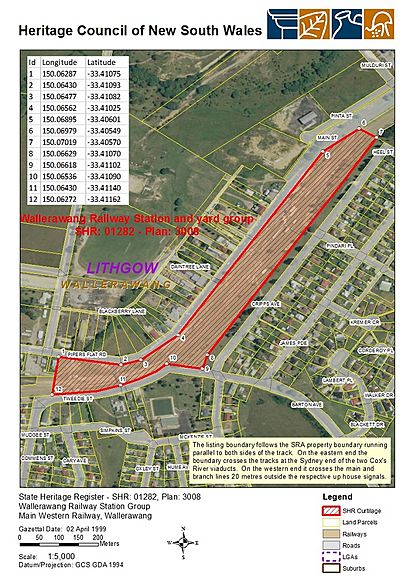Wallerawang railway station facts for kids
Quick facts for kids
Wallerawang
|
||||||||||||||||
|---|---|---|---|---|---|---|---|---|---|---|---|---|---|---|---|---|

Heritage boundaries
|
||||||||||||||||
| Location | Main Street, Wallerawang | |||||||||||||||
| Coordinates | 33°24′28″S 150°04′05″E / 33.4079°S 150.0681°E | |||||||||||||||
| Elevation | 892 metres (2,928 ft) AHD | |||||||||||||||
| Owned by | Transport Asset Holding Entity | |||||||||||||||
| Operated by | State Rail Authority | |||||||||||||||
| Line(s) |
|
|||||||||||||||
| Distance | 171.3 km (106.4 mi) from Central | |||||||||||||||
| Platforms | 2 side | |||||||||||||||
| Tracks | 2 | |||||||||||||||
| Other information | ||||||||||||||||
| Status | Closed | |||||||||||||||
| History | ||||||||||||||||
| Opened | 1 March 1870 | |||||||||||||||
| Closed | May 1989 | |||||||||||||||
| Previous names | Mudgee Road | |||||||||||||||
| Services | ||||||||||||||||
|
||||||||||||||||
| Official name | Wallerawang Railway Station and yard group | |||||||||||||||
| Type | State heritage (complex / group) | |||||||||||||||
| Designated | 2 April 1999 | |||||||||||||||
| Reference no. | 1282 | |||||||||||||||
| Type | Railway Platform/ Station | |||||||||||||||
| Category | Transport - Rail | |||||||||||||||
The Wallerawang railway station is an old train station in Wallerawang, New South Wales, Australia. It's no longer used for trains. This station is special because it's considered a heritage-listed site. This means it's an important historical place that needs to be protected.
It's located on the Main Western line. The station and its surrounding area are also known as the Wallerawang Railway Station and yard group. It was added to the New South Wales State Heritage Register on April 2, 1999. This register lists places that are important to the history and culture of New South Wales.
Contents
History of Wallerawang Station
The Wallerawang station first opened on March 1, 1870. At that time, it was the very end, or terminus, of the Main Western line. This line had just been extended from Bowenfels.
Just a few months later, on July 1, 1870, the train line was made even longer. It was extended from Wallerawang to Rydal. When it first opened, the station was called Mudgee Road. But in 1873, its name was changed to Wallerawang.
In 1880, work began on a brand new train line. This line was going to Mudgee and was the first part of the Gwabegar line. When it was finished in May 1882, Wallerawang became a junction station. This means it was a place where two or more train lines met and branched off. The new line branched off about 600 meters west of the station.
The station stopped being used for passenger trains in May 1989. This happened because the State Rail Authority decided to use road coaches instead of trains for trips between Lithgow, Orange, and Mudgee. Even though trains no longer stop there, road coaches still pick up and drop off people across the street from the old station.
What the Station Looks Like
The Wallerawang railway station area is made up of several parts. These parts include:
- Station Buildings:
- The main building on Platform 1 is made of brick. It was built in 1870 and served as both a station and a home.
- Platform 1 also has a special roof, called an awning, added in 1883. This provided shelter for passengers.
- On Platform 2, there's a wooden waiting shed that was built in 1913.
- Signal Boxes: There are two signal boxes, one to the east and one to the west, both built in 1915. These were used to control train movements.
- Goods Shed: A large shed, about 84 by 24 feet, made of corrugated iron. It was built in 1882 and used for storing goods.
- Platform Faces: The edges of the platforms are made of stone and brick, built in 1870.
- Pedestrian Bridge: A bridge that allowed people to walk safely to Platform 2.
- Water Column: A tall pipe used to fill steam trains with water.
- Water Tank: A large cast iron tank on a metal base, also for train water.
- Jib Crane: A crane built in 1882, used for lifting heavy items.
- Signals: Old-style upper and lower quadrant signals that told train drivers when it was safe to go.
- Landscaping: The gardens and outdoor areas around the station.
- Enamel Signs: Old signs made of enamel.
Why This Station is Special
As of 2002, the Wallerawang station and its yard are very important. It was a major place where train lines met. The buildings there are great examples of different styles from various time periods. They are also in good condition.
The main station building is especially rare. It's one of the best examples of a two-story building that was both a station and a home. It's also unusual because it's made of stone. The awning over the platform is also unique. It shows how important this location was, as it needed extra shelter for many people.
The signal box on the platform is another rare find. It's a large brick and timber box that is still in good shape. All the other structures in the yard, like the goods shed and other buildings, are good examples of their types. Together, all these parts show what a big and important train facility this once was. Because of all these reasons, the site has a very high heritage significance.
The Wallerawang railway station was officially listed on the New South Wales State Heritage Register on April 2, 1999. It met the requirements for being a special historical place.
Rare Features of the Station
This station is considered rare in several ways:
- It's historically rare, meaning it has a unique past.
- It's scientifically rare, which means it offers special insights for study.
- It's architecturally rare, showing unusual building styles.
- It's socially rare, meaning it has a unique connection to the community's past.

